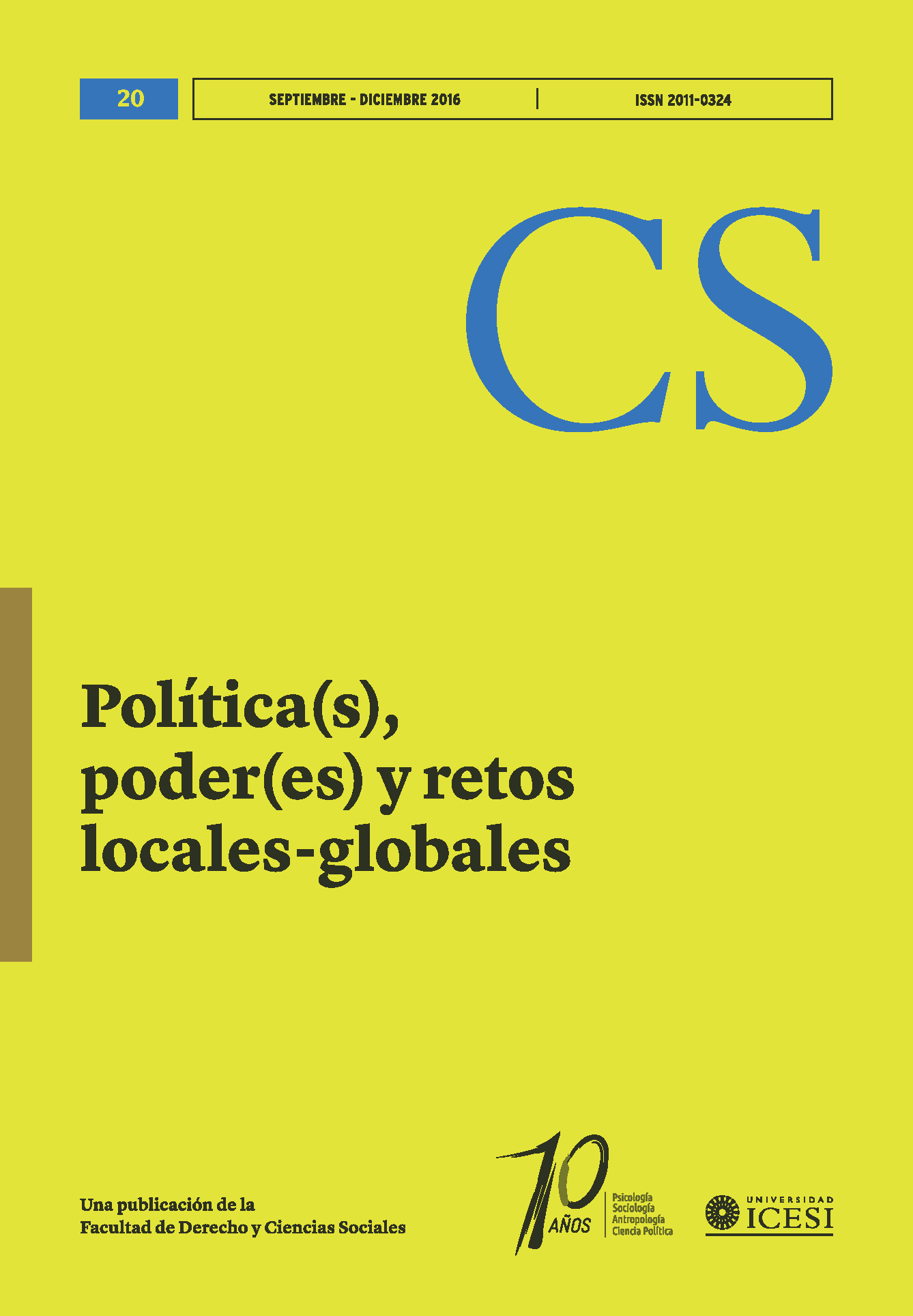Street-level bureaucrats: Difficulties to Access and Care Strategies in the Declaration and Registration Process for Victims of Army Conflict
DOI:
https://doi.org/10.18046/recs.i20.2145Keywords:
Victims of Army Conflict, Public Policy, Street-level bureaucrats, Cali-ColombiaAbstract
Based on a diagnosis of the daily practices of state agencies at local levels and their contribution to the process of restoring fundamental rights, this paper proposes an evaluation of the public policy conceived for attention to the internal army conflict’s victims. By the application of a case study -on the Declaration and Registration Process developed by the Victim's Assistance and Orientation Unit of Cali- it identifies two main access hindrances: the ones affecting the exercise of the victim’s rights and the institutional interferences that limiting the bureaucracies operation. Street-level bureaucrats have been implementing formal and informal strategies which mitigate some of the negative effects of such identified hindrances.Downloads
References
Barbary, O., y Urrea, F. (. (2004). Gente negra en Colombia. Dinámicas sociopolíticas en Cali y en el Pacífico. Cldse, Ird, Colciencias.
Barrera, L. (2011). Más allá de los fines del derecho: expedientes, burocracia y conocimiento legal. Íconos. Revista de Ciencias Sociales. (41), 57-72.
Bozeman, B. (2007). Public Values and Public Interest: Counterbalancing Economic Individualism.
Buchely, L. (2014) Las Burocracias. Estudio preliminar. Bogotá: Siglo del Hombre Editores.
Castillo, Salazar y Pinzón (2008). ¿A dónde ir? Un análisis sobre el desplazamiento forzado. Cali: Programa Editorial Universidad del Valle.
Castillo, L. C. (2012). Cali, ciudad pluriétnica, multicultural y de resistencia de negros e indios. En E. Morera A., Historia de Cali Siglo XX. Tomo II (págs. 376-411). Santiago de Cali: Universidad del Valle.
CODHES. (2013). La crisis humanitaria en Colombia persiste. El Pacífico en disputa . Bogotá: Documentos Codhes 26.
CODHES. (2014a). Desplazamiento masivo y múltiple. Enero-Noviembre de 2013. Bogotá: Informe No. 81.
CODHES. (2014b). Cifras/ Estadísticas históricas del desplazamiento año 1992-2012. Obtenido de http://codhes.org/index.php?option=com_si&type=1 Recuperado en junio de 2013.
Comité Internacional de la Cruz Roja (2007). Una mirada a la población desplazada en ocho ciudades de Colombia: respuesta institucional local, condiciones de vida y recomendaciones para su atención. Bogotá: CICR - PMA
Departamento Administrativo para la Prosperidad Social. (2012). Anexo. Plan Nacional para la Atención y Reparación Integral a las Víctimas. Obtenido de https://www.dnp.gov.co/LinkClick.aspx?fileticket=tbxvV6M0DGg%3D&tabid=1080
Figley C. R., (1995). Compassion Fatigue: Coping with Secondary Traumatic Stress Disorder in Those who Treat the Traumatized. New York: Routledge.
Herzfeld, M. (1992). The Social Production of Indifference. Exploring the Symbolic Roots of Western Bureaucracy. Londres: The University of Chicago Press
Ibánez A. M. y Velasquéz A. (2006). El proceso de identificación de víctimas de los conflictos civiles: una evaluación para la población desplazada en Colombia. DOCUMENTO CEDE 2006-36. Universidad de los Andes. Disponible en: https://core.ac.uk/download/pdf/6617775.pdf
Jaramillo A. M., Villa M. y Sánchez L. A. (2004), Miedo y desplazamiento: experiencias y percepciones. Medellín: Corporación Región
Mosquera C., Laó-Montes A. y Rodríguez C. (2010). Debates sobre la ciudadanía y políticas raciales en las Américas Negras. Bogotá:Universidad Nacional de Colombia, Universidad del Valle y CES.
Personería Municipal de Cali. (2014). Informe sobre la situación de la población víctima del conflicto armado en Santiago de Cali 2013-2014. Alcadía de Santiago de Cali.
Recalde C., G. (2013). Impacto del activismo judicial sobre la garantía del derecho a la educación en Santiago de Cali. Precedente Revista Jurídica Vol. 2, 163-204.
Red Nacional de Información de la Unidad de Víctimas. (2014). Reportes RNI. Obtenido de http://cifras.unidadvictimas.gov.co/Home/Vigencia
Rodríguez G., C., y Rodríguez F., D. (2010). Cortes y cambios sociales. Cómo la Corte transformó el desplazamiento forzado en Colombia. Bogotá: Antropos.
Rosenbloom, D. H. (2007). Reinventing Administrative Prescriptions: The Case for Democratic-Constitutional Impact Statements and Scorecards. Public Administration Review. American Society for Public Administration, 28-39.
Salazar, B., Castillo, M., y Pinzón, F. (2004). Guerra y Distrubución territotorial en el Valle del Cauca. Revista Sociedad y Economía en el Valle del Cauca, http://conflictoaprendizaje.univalle.edu.co/Articulos/guerraydistrib.pdf. Recuperado el 24 de 02 de 2013
Shore, C., & Wright, S. (1997). Anthropology of Policy: Critical Perspectives on governance and power. New York: Routledge.
Simons, H. (2009). Getting Started . En H. Simons, Case Study Reaserch in Practice (págs. 11-66). Oaks, Cal.: SAGE Publications.
Vilhena V., O. (2011). Desigualdad estructural y Estado de Derecho. En C. Rodríguez G., El Derecho en América Latina. Un mapa para el pensamiento jurídico del S.XXI (pp. 25-46). Buenos Aires: Siglo XXI editores.
Vinzant, J. C., y Crothers, L. (1998). Discretion and Legitimacy in Frontline Public Service. En J. C. Vinzant, & L. Crothers, Street-Level Leadership (págs. 32-68). Washigton, D.C. : Georgetown University Press.
Downloads
Published
Issue
Section
License
Copyright (c) 2016 Gabriela Recalde Castañeda

This work is licensed under a Creative Commons Attribution-NonCommercial 4.0 International License.
© Reserved Copyright
Material in this publication may be reproduced without authorization, provided the title, author and institutional source is acknowledged.
The content published in Revista CS is distributed under the Creative Commons BY-NC 4.0 Attribution/Recognition-NonCommercial 4.0 International license.
You are free to:
Share — copy and redistribute the material in any medium or format.
Adapt — remix, transform, and build upon the material.
Under the following terms:
Attribution — You must give appropriate credit , provide a link to the license, and indicate if changes were made . You may do so in any reasonable manner, but not in any way that suggests the licensor endorses you or your use.
NonCommercial — You may not use the material for commercial purposes.












